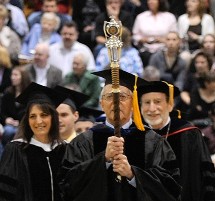Inaugural Symbols and Traditions, 2012
Academic Regalia
The custom of recognizing the accomplishments of scholars through distinctive dress, color and ceremony began in the Middle Ages and has been adopted by various academic institutions throughout the world. American academic regalia has developed from the English traditions that originated at Cambridge and Oxford, and has been in continuous use in this country since Colonial times.
Each institution of higher learning in the United States has adopted a unique and well-defined system for identifying different academic degrees by use of specific gowns, hoods and colors. The baccalaureate (bachelor's) gown is identified by long pointed sleeves. The master's gown has a very long sleeve, closed at the bottom, and the arm of the wearer is placed through an opening in the front of the sleeve. Doctoral gowns are distinguished by velvet panels around the neck and down the front of the gown. Three horizontal velvet bars on each sleeve also may mark the doctorate. The colorful hoods worn by master's and doctoral graduates represent the specific degree earned and the degree-granting institution.
The Mace
 During the Middle Ages, the wood mace clad in metal was an effective weapon in battle, but as newer and more powerful military arms developed, it was transformed into a symbol of dignity and authority. The earliest ceremonial maces were borne by bodyguards of 12th century English and French kings; by the end of the 16th century, they were used widely by officials of English cities and towns. Today the use of the ceremonial mace is found in the British Houses of Parliament, and is carried before ecclesiastical dignitaries and in university and college convocations and commencements.
During the Middle Ages, the wood mace clad in metal was an effective weapon in battle, but as newer and more powerful military arms developed, it was transformed into a symbol of dignity and authority. The earliest ceremonial maces were borne by bodyguards of 12th century English and French kings; by the end of the 16th century, they were used widely by officials of English cities and towns. Today the use of the ceremonial mace is found in the British Houses of Parliament, and is carried before ecclesiastical dignitaries and in university and college convocations and commencements.
Fredonia's current mace was presented by the Fredonia Alumni Association to the university in 1972 and is dedicated to the late Mary H. Cranston, former faculty member and Dean of Women, and the late Anna B. Haskin, a lifelong friend of the university. Assisting the alumni association with the creation of the mace was the late Helen (Clees) McKee, '40, '62.
The Presidential Medallion
Another symbol of authority, the presidential medallion is worn around the president's neck at ceremonial occasions such as commencements and convocations. The most recent medallion, made of pewter and pictured at the right, was worn by Presidents Donald A. MacPhee and Dennis L. Hefner. They wore the medallion suspended by a simple narrow braided metal chain. Dating from the early 1980s, the medallion still has the word "college" which the campus has dropped from its official seal. At the recommendation of the Inauguration Planning Committee, this medallion is being retired in September of 2012 and will be retained as an historic artifact. It will be replaced with a new medallion and chain of office as described below.
The New Chain of Office
Chains of Office are one of the oldest symbols of authority. They have been worn as early as the days of the Roman Empire and displayed by emperors, kings, pharaohs, and religious figures as physical representations of their power and position.
The tradition of the chain of office was passed down through the Middle Ages and coincided with the rise of the university system in Europe. Many of these European institutions of higher learning were branches of the church or connected to royal power, and soon the chain of office became a treasured part of university practice.
When American colleges and universities began to establish themselves in the 17th century, they adopted the same chain of office tradition from their European counterparts. Today, this custom is as strong as ever throughout the world.
For President Horvath's investiture, the Fredonia College Foundation, with support of private donors, has commissioned a new chain of office, similar to the one above, as well as a new medallion. Fashioned of antiqued bronze, the chain will include links engraved with the names and dates of past campus presidents, as well as links engraved with names (and architectural icons) representing the four major historical eras of the institution: Fredonia Academy, Fredonia Normal School, Fredonia State Teachers College and SUNY College at Fredonia. The design is emblematic of the idea that each president, as well as the campus as whole, stands on the shoulders of those that came before.
